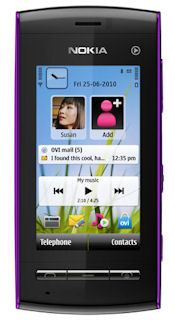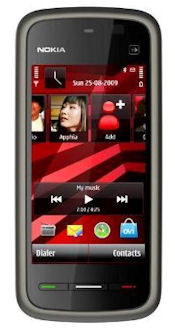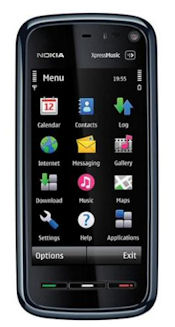Introduction
Yesterday, Nokia announced the 5250, which at €115 is its cheapest ever smartphone. Indeed it is the cheapest ever mainstream smartphone from any manufacturer (launch pricing). Some will quibble at the smartphone designation, but there's no hiding from the fact that the 5250 is running the Symbian^1 platform - and that makes it a smartphone.
As we mentioned before, the generally accepted smartphone definition ('open' platform capable of running native third party applications) now encompasses an increasingly wide range of devices, which, arguably, makes the smartphone categorisation somewhat meaningless. However, the fact remains that the ability to add third party applications and services does significantly change the potential of a device. You can argue that low-end users don't really make use of that potential, but that's a factor that will lessen in time. Clearly usage patterns will always vary; in general, less content will be consumed on lower end devices, but that will be offset by volume.
All of this means that the low-end smartphone segment is an important area. Nokia have done well in this segment in the last year, but against the backdrop of poor performance, most notably in the Nseries range, its achievements have gone largely unheralded in the media. The 5800 became a 'hero' device for Nokia, so much so that it spawned a wide range of follow up devices. Similarly, the Nokia 5230, announced at Nokia World last year, was largely ignored by the media, in favour of devices like the N97 and N900.
In this light, it is worth taking a more detailed look at the 5250. What exactly has Nokia cut out and what impact will this have? To make things easy, we have a comparison table below, which highlights some of the key differences between the 5250, 5230 and 5800. It is worth noting that there are a number of 5230 variants, all of which look very similar, the specifications of the original 5230 are used in this comparison.
Nokia 5250 vs 5230 vs Nokia 5800 specification comparison
| Model | Nokia 5250 |
Nokia 5230 |
Nokia 5800 |
|---|---|---|---|
| Technical Profile | |||
| OS/UI | Symbian^1 (S60 5th Edition) | Symbian^1 (S60 5th Edition) | Symbian^1 (S60 5th Edition) |
| Software Notes | Basic homescreen, full kinetic scrolling | Basic homescreen, full kinetic scrolling | Basic homescreen, kinetic scrolling (in updated firmware) |
| Form factor | Touch-only candybar | Touch-only candybar | Touch-only candybar |
| Internal Memory | 51MB | 70MB | 81MB |
| microSD | Yes, no card | Yes, no card | Yes, 2 GB card |
| Processor | ARM 11 at 434 MHz | ARM 11 at 434 MHz | ARM 11 at 434 MHz |
| RAM | 128 MB | 128 MB | 128 MB |
| Dimensions (LxWxH) | 105.0 mm 15.0 mm 14.5 mm |
111.0 mm 51.7 mm 14.5 mm |
111.0 mm 51.7 mm 15.5 mm |
| Volume | 68.74cc | 78cc | 83cc |
| Mass | 106.7g | 113g | 109g |
| Display size | 2.8" | 3.2" | 3.2" |
| Display resolution | 640 x 360 | 640 x 360 | 640 x 360 |
| Energy Profile | |||
| Battery | BL-4U (1000 mAh) |
BL-5J (1320 mAh) |
BL-5J (1320 mAh) |
| Standby Time (for GSM) | 19 days | 18 days | 17 days |
| Talk time | 7.7 hrs GSM No 3G |
7 hrs GSM 4.3 hrs 3G |
8.8 hrs GSM 5 hrs 3G |
| Charging | 2mm | 2mm | 2mm |
| Camera | |||
| Resolution | 2 Megapixel | 2 Megapixel | 3.2 Megapixel |
| Optics | Fixed | Fixed | Auto Focus, Carl Zeiss |
| Flash | None | None | Dual LED |
| Connectivity | |||
| Operating Frequencies | GSM/EDGE 850/900/1800/1900 | HSDPA/WCDMA 900/1900/2100 GSM/EDGE 850/900/1800/1900 |
HSDPA/WCDMA 900/1900/2100 GSM/EDGE 850/900/1800/1900 |
| Bluetooth | 2.0 + A2DP & AVRCP | 2.0 + A2DP & AVRCP | 2.0 + A2DP & AVRCP |
| WLAN | No | No | IEEE 802.11b/g |
| GPS/Navigation | No | Integrated A-GPS | Integrated A-GPS |
| USB | microUSB | microUSB | microUSB |
| Pricing | |||
| Current price | Est. £110 when available (£50 PAYG?) | £120 SIM-free (£70 PAYG) | £190 SIM-free (£150 PAYG) |
| Launch price | €115 | €149 | €279 |
| Age (from launch) | N/A | 11 Months | 22 Months |
Observations
As you can see there are some important differences between the three devices. The absence of 3G on the 5250 may raise some eyebrows, but there are still many markets that do not have comprehensive 3G coverage. Download speeds, when restricted to EDGE, rules out only a relatively small number of use cases, although patience may be required. The camera limitations lower the quality of multimedia content creation, but do not remove the functionality altogether. The absence of GPS means mapping and location functionality are severely restricted, and is probably the most significant omission, but corners do have to be cut somewhere.
The smaller touchscreen, down to 2.8" from 3.2", may have the biggest day to day impact in terms of ease of use. The smaller battery size, even with absence of 3G, will also be a concern, especially in areas with unreliable electricity supplies. However both of these elements do little to limit potential functionality. By comparison, the absence of a microSD card in the box is a significant limitation, but it is one that can easily be rectified.
Until we get hands-on with the device it is not possible to make any judgements about the quality of the build hardware components and materials. However, past experience would suggest that while there will be some compromises (e.g. poor viewing quality in bright sunlight), there are unlikely to be terminal compromises. More than anywhere else in the specification list, the maxim of 'you get what you pay for' applies here.
Software wise, there's very little to choose between the three devices. Outside of the location arena, the device should be capable of running most of the same applications as any other Symbian^1 device. S60 5th Edition may have its critics, but it looks attractive when compared to the proprietary software running on competing touch devices at this price point.
Price is the key point here, the lower down you go the more sensitive consumers become to pricing. The 5250 comes in at €115, which is €35 cheaper than the 5230. That may not seem like much to those willing to spend €500+ on a device, but here it represents 30% of the cost of the device.
Device prices start dropping as soon as a phone hits the shelves. When it arrives later this year, the SIM free price of the 5250 will be similar to the 5230. However, that will change over time and the 5250 should establish a sub £100 price point in relatively short order and, if the 30% price difference is transmitted into the PAYG market, we can expect the 5250 to be the first sub £50 smartphone.
It is clear that the 5250 would leave most existing smartphone users disappointed, but despite the numerous cuts, the device retains a surprising amount of the potential of smartphones. In that light it should be seen as an attractive upgrade for a sub-£100 feature phone owner or the first step on the road to a personal computing device.
Rafe Blandford, August 2010
